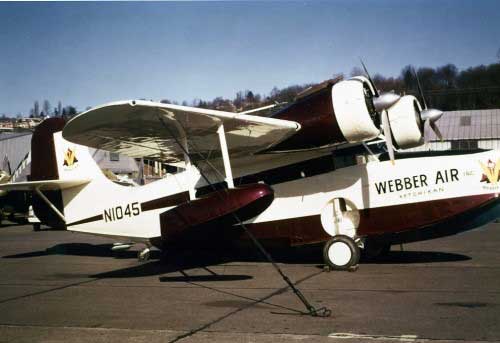
1978 Lab Bay Goose Crash was most deadly on recordAfter 40 years, still no explanation for crash that killed 12By DAVE KIFFER
August 30, 2018
The Goose had been the dominant mode of air transportation between the communities in Southeast from the end of World War II to the early 1970s, but with most of the larger communities getting jet airports, the regional air taxi industry was transitioning to smaller float planes such as the Cessna 185 and the DeHavilland Beaver to continue operations into the even smaller and more isolated communities.
By 1985, PenAir in southwestern Alaska was the last United States carrier still regularly using Grumman Goose aircraft, although at least one Canadian company, Pacific Coastal was still flying the Goose. PenAir made its last Grumman Goose flight, in the Aleutian Islands, in 2012. Like nearly all the Grumman Goose "amphibs" that flew in Alaska, the Webber Air plane was built during World War II. After the war, M.L Hardy of Pennsylvania purchased it for $6,800. In 1948, he sold it to Dr. Walter Stafford of Massachusetts. In 1951, the giant contractor Morrison-Knudsen purchased the plane for $32,500. During the Cold War build up, Morrison-Knudsen had numerous projects in Alaska and the Goose was reported being towed into Nome by the Coast Guard Buoy Tender Clover after an engine failed 40 miles southwest of Nome. Shortly after that, Vince Daly began an air service in Alaska and purchased the Goose for $37,000. After five years of operating primarily in the Kodiak area, he sold the Goose back to Morrison for $55,000. Morrison kept the aircraft for three more years and then it passed through several owners before it was purchased by B.C. Airlines. In March of 1965, it suffered an unknown accident that cause it be declared a total loss. But, of course, its flying time was not over. Frequently, "totaled" aircraft in the Northwest eventually find their way back to airworthiness depend on how much owners are willing to spend and replace. It was sold two more times and finally rebuilt by a company in Seattle. It was ready to go by January 1968 and was purchased by Webber Air in Ketchikan. Webber operated the plane for the next six years and then sent it in for a complete overhaul. In 1977, records show that the aircraft suffered a "hard landing" and needed significant repair, primarily to the engine mounts and cowlings. That was the last time the plane showed up in government records before the fatal crash of August 25, 1978. According to Gregory Leifer's 2014 book "Broken Wings: Aviation Disasters in Alaska," Webber Airlines had originally sent a smaller aircraft to Prince of Wales to pick up passengers the morning of August 25, but that it had been unable to traverse the cross island passes because of bad weather. It was decided the plane would try again later in the day. "Jack Swain, one of the company owners, instead decided to fly the Grumman Goose, since the amphibian could carry both groups of passengers from the morning and afternoon flights and would alleviate the need for a second aircraft," Leifer wrote. "One of the passengers also had a connecting flight in Ketchikan and he (Swaim) felt obligated on getting him there in good time." Swaim left Ketchikan at 1 pm, there was a thick overcast in Clarence Strait with occasional rain showers. There was a slight breeze and conditions appeared fine for flight. At 1:45, the Goose landed at Nichen Cove on Tuxekan Island and then pulled In to the dock at Naukati. Both the morning and afternoon passengers, a total of seven. and their luggage were loaded onto the plain. Two other passengers wanted to fly to Labouchere Bay, a logging camp on the Northwest corner of Prince of Wales, but they were told to wait for a later flight. "Swaim was already irritated by weather delaying the schedule and became more irritated with the ensuing discussion over the two additional passengers," Leifer wrote. "He was in a hurry." The plane was certified for 10 passengers, but the extra gear bound for Lab Bay took up the rest of the plane's capacity. The plane left Naukati and flew on to Lab Bay where it arrived at 2:20 pm. Two of the passengers deplaned at Lab Bay and six more additional passengers joined the flight. There was more disagreement about passengers at Lab Bay. "A heated discussion then developed between Swaim and a remaining passenger (in Lab Bay) who had been scheduled without his knowledge," Leifer wrote in 2014. "He became more irritated as the conversation continued and would not allow her on the aircraft. The plane already held a total of 11 passengers, one over the maximum limit." At 2:35 pm, the plane took off from Lab Bay and turned north into Sumner Strait. Swaim contacted Webber in Ketchikan and reported that he planned to stop in Whale Pass and Coffman Cove before returning to Ketchikan. That was the last that was heard from Webber Airlines Goose. "A truck driver later reported seeing the Grumman Goose three and a half miles north of Labouchere Bay, passing the tip of Prince of Wales Island," Leifer wrote. "He was parked on a logging road near Point Baker and observed the plain flying a few hundred feet above the water in relatively good weather." What happened next remains a mystery, forty years later. "Debris found in the water almost two hours later indicated the plane hit the surface with violent force, broke apart on impact and sank," Leifer wrote. "Whether the accident was caused by pilot error, weather or mechanical failure was never determined." Most of the plane was presumed sunk in more than 1,200 feet of water and was never recovered. Initially the plane was assumed to be merely delayed by weather, but when the Unimak, a commercial halibut boat from Wrangell, found debris and an oil slick a mile off shore from Point Baker, the Coast Guard immediately began searching the area. Eventually, four bodies, baggage and other debris was found. Bodies of the other eight people on the flight were never recovered. The investigation eventually determined the plane likely crashed shortly after it was seen by the truck driver, but the National Transportation Safety Board could not come to a conclusion about what would cause an apparently normally operating airplane to suddenly spiral into the water. Initially, according to stories in the Ketchikan Daily News, investigators keyed in potential overloading. The plane was authorized for 8,920 pounds and because of some confusion about who would or would not be on board the plane the plane was at least 400 pounds over that threshold. The number of passengers on board could also have been a factor. The plane was authorized to carry 11 people, including the pilot. But the Goose took off from Lab Bay with 11 passengers and the pilot. Weather conditions were listed as marginal visual flight rules, but there was heavy fog in parts of Sumner Strait when the plane left Lab Bay. "Mechanical problems or structural failure could have contributed to the accident," Leifer wrote. "A helicopter pilot who arrived over the area at 7:00 pm reported seeing two separate oil slicks about a half mile apart. He believed they were from the engines, their proximity from each other indicative of structural failure. The dispersal was inconclusive, however, since nearly four hours had passed from the approximate time of the incident." Other possible causes could have been spatial disorientation if the plane entered a thick fog bank, but once again that could only be speculated. Autopsies on the four recovered bodies, who had all in the back of the plane, indicated they had died of blunt trauma. A watch worn by one had stopped at 2:45 giving investigators their best clue as the time of the accident. The logging communities and Ketchikan mourned the victims. The crash hit the Forest Service particularly hard as seven of the dead were seasonal USFS employees. The victims included two Labouchere Bay residents, Jean Gaedecke, 56 and Margaret "Patty" Murphy, 53. The most well known person - besides the 44 year old Swaim - on the flight was Mildred Manty, 67, a longtime local public health nurse. She had been named Ketchikan's Distinguished Citizen of the Year in 1975. Manty was known to many as the "logging camp nurse" because she spent much of her time traveling between the 15-20 logging camps in the region that provided timber to the Ketchikan Pulp Mill. According to the Ketchikan Daily News, she had previously worked in Hawaii and had been named "Woman of the Year" in 1956. She came to Alaska in 1963. Another passenger on the flight was Norman Perue, 47, was an employee of road building company Iaco. The Forest Service employees on the fatal flight were Dwain Yothers, 38; Dave Blackburn, 30; Daniel Kwapich, 21; Bert White, 45; Jerry Kowalski, 26; Gene Gray, 27; and Jerry Macios, 24. Forty years later, there remains no explanation why their flight suddenly crashed into the waters of Sumner Strait just off Prince of Wales Island. Webber Air, which had been operating in Ketchikan since 1946, would only last for an additional 11 months. It was merged with another carrier, Flair Air in July of 1979 under the new name of South East Alaska Airlines or SEA Air.
On the Web:
Contact Dave at dave@sitnews.us Dave Kiffer ©2018 Republication fee required. Representations of fact and opinions in comments posted are solely those of the individual posters and do not represent the opinions of Sitnews.
|
||||





